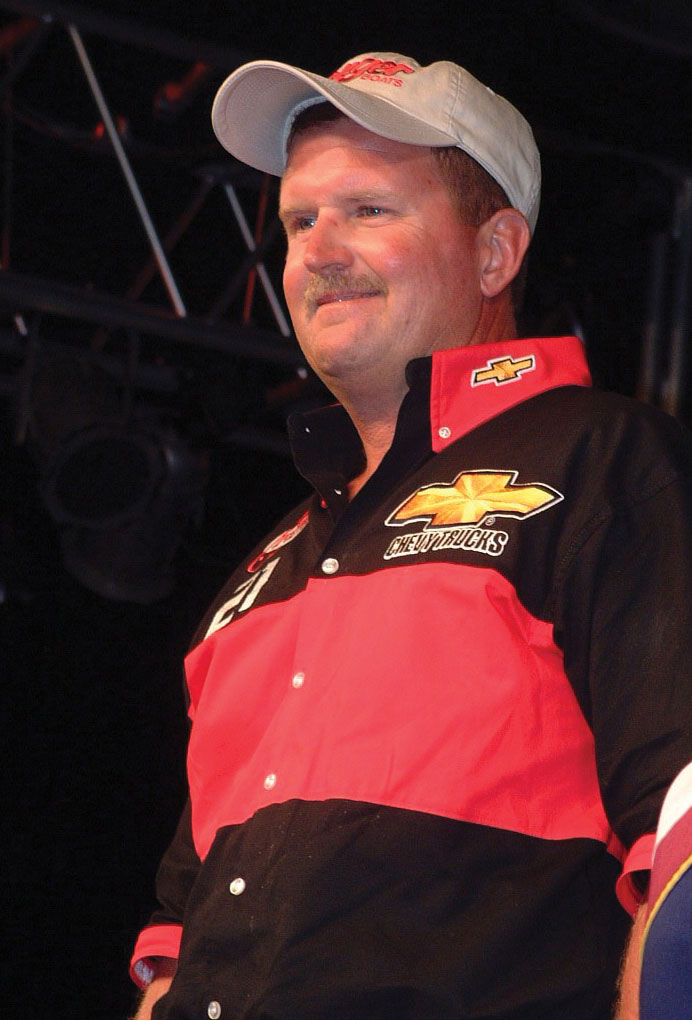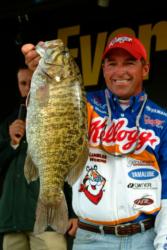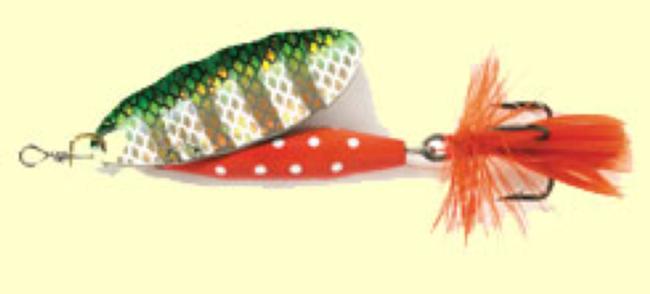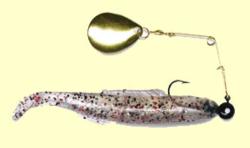Largemouth free fall

As summer wanes, where do anglers who want to catch a few bass have to go, and what do they have to do when they get there? What are the keys?
Where are they?
Kellogg’s pro Clark Wendlandt of Cedar Park, Texas, said he first looks toward the backs of creeks.
“The shad move in there, and the bass follow,” he said. Shad prosper in the warm water of the summer months, roaming the main lake. As water cools, the water in the backs of the creeks is the last to turn cold. Thus, the shad move there.
 “I try to determine whether the particular creek is one with a clearly defined channel, or is it mostly an extended flat?” Wendlandt said. “If there is a clearly defined channel, I fish the actual channel – specifically, the drop-offs and any stumps that may be there. If it is mostly an extended flat, I simply start at the back and work out. If there is grass of some kind, I may go to the grass first. If you can catch bass in one creek, chances are you can catch them in the next creek up or down as well.”
“I try to determine whether the particular creek is one with a clearly defined channel, or is it mostly an extended flat?” Wendlandt said. “If there is a clearly defined channel, I fish the actual channel – specifically, the drop-offs and any stumps that may be there. If it is mostly an extended flat, I simply start at the back and work out. If there is grass of some kind, I may go to the grass first. If you can catch bass in one creek, chances are you can catch them in the next creek up or down as well.”
Wal-Mart Bass Fishing League veteran Maurice Freeze of Kannapolis, N.C., agreed. “In the early fall, say mid-September to mid-October, I fish very shallow, and the shallower the better – usually 3 feet or less,” he said. “I’m looking for brush, piers, rocks, logs – some sort of structure along the bank in the backs of the creeks.”
“I also look for current,” Freeze said. “Current is the key to water quality, and the best water for bass has current.”
As fall deepens toward winter, Freeze moves out to the main lake. “From mid-October to mid-November, I fish deeper in the creeks and then move out to fish the main lake,” he said. “Fishing there is starting to pick up. I throw small crankbaits on rock piles and channel banks.”
Craig Johnson of Martinez, Ga., is an excellent autumn angler. He won the Chevy Trucks Wild Card tournament at West Point Lake on the Georgia-Alabama border in November last year, proving he knows a thing or two about fall fishing.
 “In the fall, schools of shad gather in creek channels,” he said. “They are just running around back there, so we (in the Southeast) fish a lot of open water in the creeks.”
“In the fall, schools of shad gather in creek channels,” he said. “They are just running around back there, so we (in the Southeast) fish a lot of open water in the creeks.”
Bobby Horn of Lake Havasu City, Ariz., fishes the deep Western reservoirs. The backs of creeks along the Colorado River chain of impoundments are very different from many of the largemouth-bass reservoirs in other parts of the country. Horn is also an excellent fall angler – last November he topped the field at a Wal-Mart Bass Fishing League tournament on Lake Havasu.
“You are more likely to get fish up the river in the fall than in the summer,” Horn said. “Fish are always in the river sections, and when you get bit, it’s usually a good fish, 3 to 5 pounds.”
Lures
Wendlandt said he uses several lures for fall fishing depending on the type of water he is fishing. In areas without a clearly defined creek, Wendlandt often fishes a lipless crankbait, particularly a Rat-L-Trap.
Wendlandt also makes extensive use of top-water baits in the fall. “My choices are either a chugger-style or a Spook,” he said. “I throw a buzzbait along the bank, too.”
In lure selection, Wendlandt said the biggest key is to let the fish tell you what they want. “If the key forage is shad, align your colors with shad,” he said. “If fishing is tough, it is especially important to try to align color and size with the available forage.”
 Freeze also likes top-water action in the fall, particularly Pop-Rs, but he also uses plastics for autumn fishing, usually in red-shad colors. “Flipping tubes or small worms are excellent lures for fall bass,” he said. “I use a small weight – a quarter ounce or less.”
Freeze also likes top-water action in the fall, particularly Pop-Rs, but he also uses plastics for autumn fishing, usually in red-shad colors. “Flipping tubes or small worms are excellent lures for fall bass,” he said. “I use a small weight – a quarter ounce or less.”
Top-waters and plastics are not the only bait Freeze finds productive. “In the early fall period, small spinner baits are best, 3/8-ounce or less,” he said. “Later in the fall, larger spinner baits slow-rolled along ledges and deeper water in the creeks work better.”
For cranking, Freeze likes either a Speed Trap or a Shad Rap in smaller sizes in the early fall and large ones as autumn progresses. “In clear water, I stick to a shad color for crankbaits,” he said. “If the water turns discolored, then I switch to a crawfish color.”
 Johnson won the Chevy Trucks Wild Card with a spinner bait, and it was the first lure he mentioned when questioned about fall fishing. “In the clear water like we have on my home lake, Clarks Hill, I use a small spinner bait and retrieve it pretty fast, usually just under the surface, and make it wake,” he said. “Not many people do that, and it’s something the bass have not seen very often.”
Johnson won the Chevy Trucks Wild Card with a spinner bait, and it was the first lure he mentioned when questioned about fall fishing. “In the clear water like we have on my home lake, Clarks Hill, I use a small spinner bait and retrieve it pretty fast, usually just under the surface, and make it wake,” he said. “Not many people do that, and it’s something the bass have not seen very often.”
If the spinner bait does not work, Johnson throws a crankbait. “A crankbait is something you can catch fish on from October to April,” he said. “A Little N is great. It backs straight up if you stop reeling, so it can back out of the grass that we fish here.”
Johnson also uses a No. 5 or No. 7 Shad Rap, though he switches from bait-casting gear to spinning equipment when he does so. “The Shad Rap is probably the most fish-catching lure in the world,” he said.
In clear water, Johnson relies on a baby-bass color on crankbaits and changes to brown back and chartreuse sides in muddier water.
Horn’s fall lure choices are similar but not identical to the other pro anglers’ choices. “Up in the river section of our reservoirs, I throw a Sweetwater jig into shallow water,” he said. “Usually I’m throwing a brown jig with either a brown or purple Super Pork Frog Trailer. Sometimes I switch to a black jig and a blue Pork Frog. Mostly I flip into the tules, a cattail-like plant that grows out here.”
Horn also hits main-lake areas, particularly points, with a Poe 400 crankbait in a ghost color. “Basically my strategy in the fall is to start with the crankbait on the main lake,” he said. “If nothing happens, switch to the jig. If that does not work, go up the river and flip the jig in the tules.”
Drop-shotting has become popular in Western reservoirs and is moving across the country. Horn noted the popularity of this technique and said, “Lots of folks out here go to drop-shotting, and I do that at times, especially at Lake Mead. It’s a light-line, deep-water method.”
Fall largemouth bonanza
Fall is an excellent time of year to fish Lakes are not so crowded – lots of guys have switched to hunting – so you don’t have to fight for a place to fish. Plus, you catch tons of fish in the fall.
If you follow the advice of these FLW Outdoors anglers, fall will be your new favorite time of year, to fish.